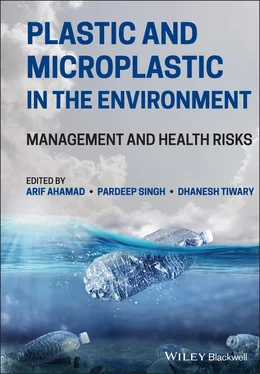Plastic and Microplastic in the Environment
Здесь есть возможность читать онлайн «Plastic and Microplastic in the Environment» — ознакомительный отрывок электронной книги совершенно бесплатно, а после прочтения отрывка купить полную версию. В некоторых случаях можно слушать аудио, скачать через торрент в формате fb2 и присутствует краткое содержание. Жанр: unrecognised, на английском языке. Описание произведения, (предисловие) а так же отзывы посетителей доступны на портале библиотеки ЛибКат.
- Название:Plastic and Microplastic in the Environment
- Автор:
- Жанр:
- Год:неизвестен
- ISBN:нет данных
- Рейтинг книги:5 / 5. Голосов: 1
-
Избранное:Добавить в избранное
- Отзывы:
-
Ваша оценка:
- 100
- 1
- 2
- 3
- 4
- 5
Plastic and Microplastic in the Environment: краткое содержание, описание и аннотация
Предлагаем к чтению аннотацию, описание, краткое содержание или предисловие (зависит от того, что написал сам автор книги «Plastic and Microplastic in the Environment»). Если вы не нашли необходимую информацию о книге — напишите в комментариях, мы постараемся отыскать её.
Thought-provoking discussions of the challenges posed by—and potential solutions to—plastic and microplastic pollution Plastic and Microplastic in the Environment: Management and Health Risks,
Plastic and Microplastic in the Environment
Plastic and Microplastic in the Environment: Management and Health Risks
Plastic and Microplastic in the Environment — читать онлайн ознакомительный отрывок
Ниже представлен текст книги, разбитый по страницам. Система сохранения места последней прочитанной страницы, позволяет с удобством читать онлайн бесплатно книгу «Plastic and Microplastic in the Environment», без необходимости каждый раз заново искать на чём Вы остановились. Поставьте закладку, и сможете в любой момент перейти на страницу, на которой закончили чтение.
Интервал:
Закладка:
3.2 Human Health Implication
The route of exposure of MPs to humans is mainly from inhalation, ingestion, and dermal contact (Prata et al. 2020). The plastics provide the food security by being less reactive and less expensive, therefore they are extensively used in the packaging of food, water, medicine, and the packaging industry in general. Studies reveal the presence of MPs in bottled mineral water (Weisser et al. 2021) and honey, among other foods. The main route of exposure to MPs are inhalation from the airborne MPs coming from the construction and demolition areas, industrial emissions, waste storage and disposal sites, such as landfill and waste reduction plants, where incineration of waste is done. These MPs are ingested along with food and water into the human body via dermal contacts, mainly by applying the cosmetics containing microbeads in them. However, fishes are a potential pathway for the entrance of MPs to human bodies (Barboza et al. 2020). The ocean is the largest producer of biomass and provides varieties of products which we use in our day‐to‐day life. There is a chance of toxicity due to xenobiotic compounds as well, which provide an important iodide source, i.e. salt. People are using cosmetics, toothpaste, and face scrubs, which have MPs of >1 μm, where the absorption of PE and PP particles in tissues can cause skin damage (Sharma & Chatterjee 2017). While our skin may provide a direct entry of MPs and other contaminants to our bodies, there are other routes which can cause direct exposure to them, such as sweat glands, open injury, and hair follicles. The microbeads present in the toothpaste are unintentionally swallowed, reach the gut, and may absorbed into the blood, which can cause chromosomal alteration, hormonal imbalance (which can lead to infertility), or cancer (Usman et al. 2020).
Plastic polymer products are pervasive in human life; therefore, their particle exposure is inevitable for humans. Humans are highly exposed to the MPs problem as they are widely present in the air, water, and soil (Campanale et al. 2020).
As foreign particles, MPs are resistant to the natural degradation process or defense mechanisms naturally present in one's body. They may cause particle toxicity, oxidative stress, disruption of immune function, or neurotoxicity (Prata et al. 2020).
If MPs enter into the gut, they are not easily excreted by the body and may cause blockage of the gastrointestinal tract, which may disturb the function of the digestive system and lead to death (Wright et al. 2013). The immune system is unable to remove them, and this leads to chronic inflammation, which may cause neoplasia; a tumorous growth potentially capable of turning into a cancerous state (Prata et al. 2020). MPs, in sizes ranging from 0.2–150 μm have a high potency of translocation in humans across the cells to the lymphatic and circulatory systems, possibly through Peyer's patches of the intestine (Hussain et al. 2001). However, this process is not well known and needs further studies.
Although human bodies are capable of excreting more than 90% of the MPs (Schwabl et al. 2019), its fate in the human body is not yet fully understood as it has associated risk of toxicity of chemicals like heavy metals (cadmium, lead, chromium etc.) (Massos & Turner 2017), hydrophobic organic pollutants (organo‐chloride, polyaromatic hydrocarbons, polychlorinated biphenyls etc.), and additive compounds (Wright & Kelly 2017). These chemicals are highly carcinogenic and easily transported to the lymphatic system (Wright & Kelly 2017). These chemicals are hydrophobic and easily adsorbed by MPs, and even a very small dose is sufficient to adversely affect the biological metabolism of humans and animals.
Due to its property of being an essential component in nutrition, common salt is extensively consumed by humans globally. Because it is also used in food preservatives, the human community consumes a small quantity of salt in almost every food item, which includes both the freshly cooked and preserved items like chips, aerated drinks, and packaged juice, etc. Salts are also found in cosmetics, pharmaceuticals, toothpaste, and other personal care products. Salts are deracinated from seawater or saline lakes, rocks, and wells. Sea salts are extracted by constructing shallow basins over salty and mineral‐rich lakes, generally referred to as salt evaporation ponds, where salts are obtained by the natural evaporation process. Prior to crystallization, the seawater is mixed with fresh water and then passed through a number of successive ponds to maintain a salinity gradient. These areas are highly prone to anthropogenic contaminants, mainly with MPs from marine debris, and this water circulation process adds contaminants into the water in the form of microbeads. Sea salts have higher MP contamination than a lake or rock salts (Peixoto et al. 2019). All these types of exposure to MP contaminants to the human body are still under investigation.
3.3 Conclusion and Future Perspective
Microplastic waste is a matter of concern for researchers, if we don't find a remediation technique then the time is not far when our green planet would be wrapped in colorful plastics. This is quite evident from the oceans, where MPs have close interaction with all segments including biotic and abiotic. They enter into the organisms bodies via food and water as per their feeding habits. However, their harmful impacts on the body metabolism of organisms largely depend upon the particles size, and the biological processes governing their presence in organisms' bodies. The organisms' bodies have different development stages such as egg, larvae, adults etc., which would define their accumulation, fate, and impacts. Some creatures have a self‐defense mechanism that restricts them to feed upon these harmful MPs that others confuse with prey and consume in huge amounts. Sometimes, particles of size <5 mm can be successfully excreted out of the body, while sometimes they cause blockage of the digestive system and are fatal to organisms.
Studies revealed the presence of MPs in sea products like common salts, which is the main source of dietary iodine to the human community, so they have potential harmful impacts on human health. Their significant presence has been seen in seafood like crustacean, mollusk, fishes, and birds, etc. Therefore, it is a matter of great concern toward food and nutrient safety and security, as human population is exposed to high concentration of these sea products.
There is a vast knowledge gap of MP toxicity in the human body due to limited research. However, the main factors behind its toxicity are largely influenced by exposure route, chemical composition, adsorbed contaminants, and susceptibility of organisms. The research on human health is ethically restricted because of biosecurity measures in human‐sample handling. Therefore, we can conclude the information of exposure and possible toxicity by reviewing the possible impacts on other organisms. However, these plastics being smaller size, generally do not pass through the biological system.
To reduce this problem, the first major step taken should be to reduce the length of our food chain, which can reduce the huge consumption of plastic used in packaging and processing the raw foods. This means fresh vegetable and fruits should be directly taken from garden to the kitchen or to the table, which will reduce the environmental exposure as well as the additional wrapping of plastics for their future use. Instead of using mineral water or packaged drinking water which is filled in plastic bottles, metal or glass bottles should be used for this purpose, as this might reduce the additional MPs in them due to leaching from plastic packagings.
Acknowledgements
The author would like to thank the editors of the book for the kind invitation to write this chapter. I would also like to place on record my thanks to the Department of Environmental Sciences, Banaras Hindu University, Varanasi, for giving me an opportunity to work in the lab of the Department.
Читать дальшеИнтервал:
Закладка:
Похожие книги на «Plastic and Microplastic in the Environment»
Представляем Вашему вниманию похожие книги на «Plastic and Microplastic in the Environment» списком для выбора. Мы отобрали схожую по названию и смыслу литературу в надежде предоставить читателям больше вариантов отыскать новые, интересные, ещё непрочитанные произведения.
Обсуждение, отзывы о книге «Plastic and Microplastic in the Environment» и просто собственные мнения читателей. Оставьте ваши комментарии, напишите, что Вы думаете о произведении, его смысле или главных героях. Укажите что конкретно понравилось, а что нет, и почему Вы так считаете.












